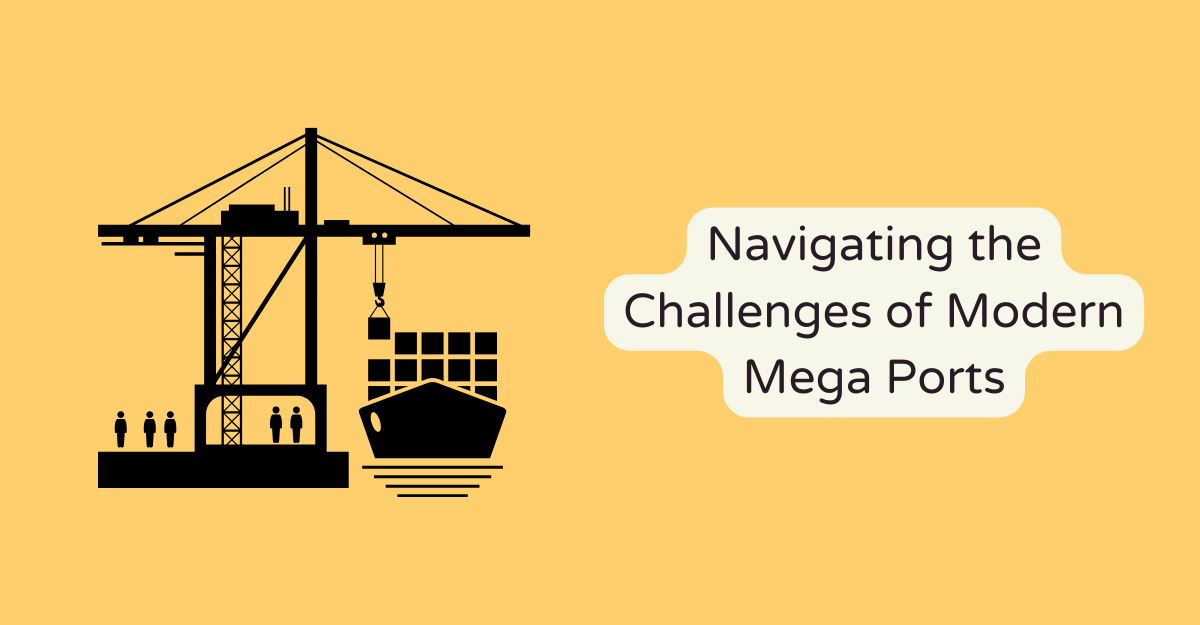
In the age of globalization, the shipping industry stands as the backbone of international trade, with over 80% of global goods transported by sea.
At the heart of this intricate network lie the mega ports, colossal hubs that facilitate the movement of vast quantities of cargo across continents.
Even in ancient times, the ports played significant roles. They were primitive at first and certainly not mega ports, but over the centuries they could manage more ships.
However, as ships grow ever larger and more technologically advanced, modern ports face a slew of unique challenges.
From environmental concerns to logistical complexities, the task of accommodating large transportation ships is anything but straightforward.
This article delves into these challenges and explores innovative solutions, including the use of automation, artificial intelligence (AI) in logistics, and green initiatives that pave the way for sustainable port development.
Environmental Concerns
One of the most pressing issues mega ports face is the environmental impact of accommodating large vessels.
The increase in ship size and port activity often leads to heightened emissions, water pollution, and habitat disruption.
To mitigate these effects, many ports are turning to green initiatives such as electrification of port machinery, implementing shore power to reduce emissions from idling ships, and developing advanced waste management systems to handle the byproducts of shipping and port operations more sustainably.
Logistical Complexities
The sheer volume of cargo that large ships carry introduces significant logistical challenges.
Ensuring the smooth, efficient handling of thousands of containers per vessel requires meticulous planning and coordination.
Ports must continually optimize their operations to reduce turnaround times and avoid bottlenecks, which can have a domino effect on global supply chains.
Advanced scheduling systems, real-time tracking technologies, and AI-powered predictive analytics are becoming indispensable tools for managing these complexities, enabling ports to anticipate issues and adjust operations dynamically.
It has become apparent that the intricate dance of managing large transportation ships extends beyond the physical infrastructure to encompass a broad spectrum of operational and administrative tasks.
This is where the role of a port agency becomes crucial in navigating the complexities of modern port operations. Port agencies (such as Seaharbor in Curacao) act as the linchpin between the myriad of stakeholders involved in port operations, including shipping lines, port authorities, cargo handlers, and customs officials.
The coordination of berthing schedules alone is a Herculean task that requires precision and foresight. A port agency facilitates this by ensuring that all necessary arrangements are in place for a vessel’s arrival, stay, and departure.
This includes everything from pilotage and tug services to cargo handling and storage solutions. Moreover, the agency plays a critical role in managing documentation and compliance, ensuring that all cargo meets local and international regulations, thereby avoiding costly delays and fines.
In addition to these operational roles, port agencies also offer vital logistical support by coordinating with local logistics and transportation providers.
They ensure that once cargo is offloaded, it is efficiently transported to its next destination, whether it’s a local warehouse or an inland transport link.
This seamless integration of services, facilitated by the port agency, is essential for maintaining the flow of goods through the port, minimizing turnaround times, and optimizing the overall supply chain.
Furthermore, in the era of digital transformation, port agencies are increasingly leveraging technology to enhance their services. Utilizing advanced software systems, they can track shipments in real-time, anticipate potential disruptions, and communicate effectively with all parties involved.
This digital approach not only increases efficiency but also adds a layer of resilience to the logistics chain, allowing for more agile and responsive operations in the face of the unexpected.
By acting as the orchestrator of port activities, port agencies significantly reduce the logistical complexities associated with handling large transportation ships.
Their expertise and services ensure that the mega ports continue to operate smoothly, reinforcing their role as critical nodes in the global supply chain.
The Need for Advanced Digital Technologies
In response to these challenges, modern mega ports are increasingly reliant on cutting-edge digital technologies. Automation plays a critical role, with automated guided vehicles (AGVs), robotic cranes, and self-driving trucks enhancing efficiency and safety within the port environment.
AI and machine learning offer powerful capabilities for optimizing logistics, from predictive maintenance of equipment to intelligent routing of cargo through the port.
Furthermore, blockchain technology is emerging as a key player in streamlining customs processes and securing the supply chain, ensuring that data integrity and transparency are maintained across the global logistics network.
Solutions and Innovations
To address environmental concerns, ports are investing in sustainable infrastructure and practices. Solar and wind power installations, along with the transition to electric and hybrid vehicles within port operations, are reducing carbon footprints.
Water treatment facilities and strict environmental regulations ensure that the maritime and surrounding ecosystems are protected.
In tackling logistical hurdles, mega ports are deploying Internet of Things (IoT) devices and sensors across operations to gather vast amounts of data, allowing for real-time decision-making and efficiency improvements.
Central to this effort is the digital twin technology, where a virtual model of the port and its operations can be used for simulation, analysis, and control.
Automation and AI are revolutionizing port operations by enabling 24/7 productivity and minimizing human error. Automated stacking cranes and AGVs are now commonplace, with AI algorithms optimizing their tasks in real-time.
AI is also enhancing security measures through advanced surveillance and monitoring systems, ensuring both safety and compliance with international regulations.
Conclusion
The evolution of mega ports is a testament to human ingenuity and adaptability, reflecting a commitment to overcoming the challenges posed by the modern age of shipping.
By embracing environmental initiatives, leveraging digital technologies, and continuing to innovate, these ports are not only ensuring their relevance in the global trade ecosystem but are also leading the way toward a more efficient and sustainable future.
As the maritime industry continues to evolve, the resilience and forward-thinking of mega ports will undoubtedly play a pivotal role in shaping the future of international commerce.





